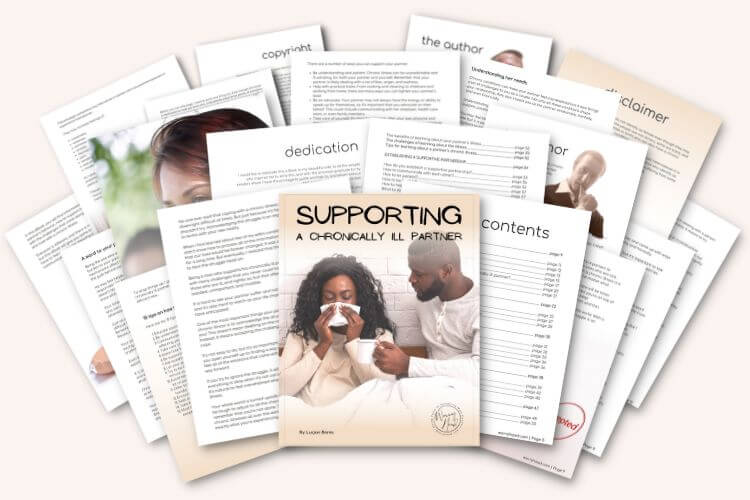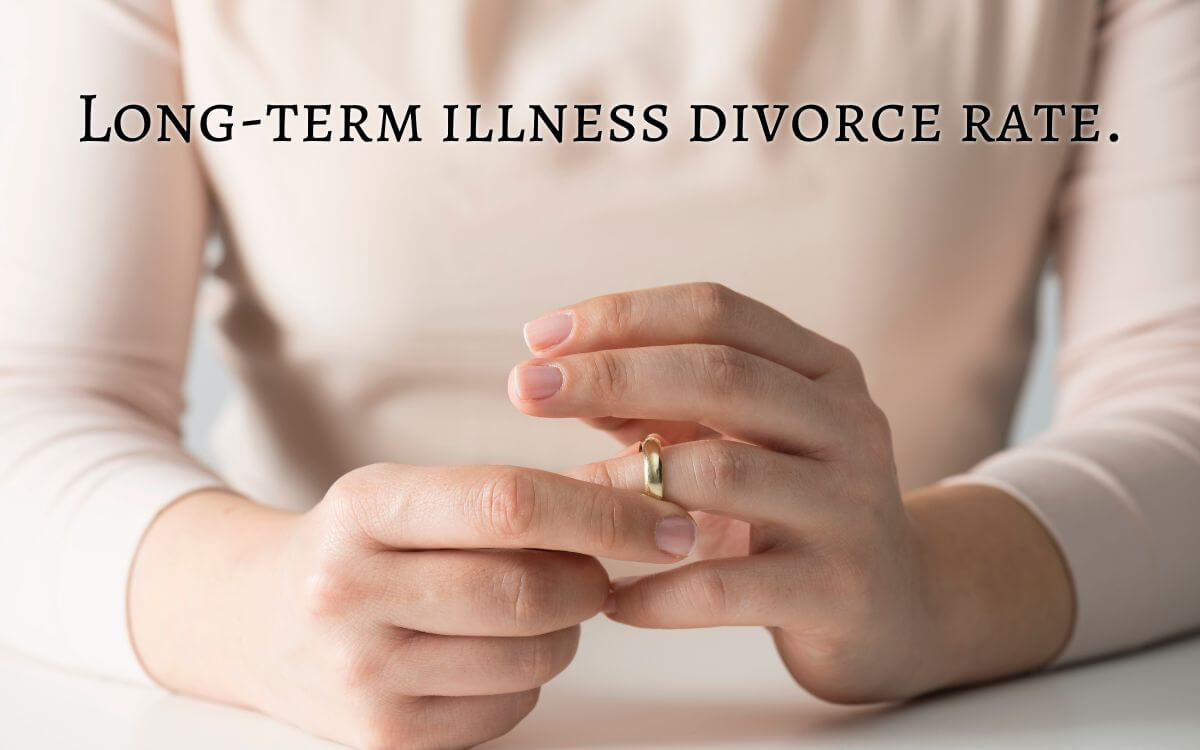Long-term illness divorce rate.
Chronic illness can put a strain on any relationship, but marriages are especially vulnerable. According to studies like this one, the long-term illness divorce rate is significantly higher than the rate for healthy couples.
There are a number of reasons why chronic illness can lead to divorce.
- Chronic illness can be very expensive. Medical bills lost wages, and long-term care costs can quickly add up, putting a financial strain on the family.
- Chronic illness can be emotionally draining. Caring for a sick spouse can be stressful and exhausting. Over time, this stress can take a toll on the relationship.
- Chronic illness can limit one’s ability to participate in activities that were once enjoyed together. When one spouse is unable to participate in activities that the other enjoys, it can lead to feelings of resentment and isolation.
- Chronic illness often leads to changes in lifestyle and routine. These changes can be disruptive and difficult to adjust to. For example, a couple may have to give up travel or social activities that they once enjoyed.
- Chronic illness can be a source of conflict in the relationship. Couples may disagree about how to best manage the illness, how to pay for treatment, or whether to have children.
If you’re facing divorce because of chronic illness, it’s important to seek out support. There are many resources available to help you through this difficult time.
What do I know about the long-term illness divorce rate?
Do I know anything about the long-term illness divorce rate and can it help to save your marriage?
Yes. I know a lot about it. My wife asked me to divorce her on four separate occasions, however, each time I refused. I gain a lot of experience and learned how to avoid divorce.
My wife suffers from multimorbidity, meaning, she has multiple chronic conditions.
Her primary condition is endometriosis, and she has the worst type – stage IV deep infiltrating endometriosis. Endometriosis is a long-term illness that has no cure. My wife’s secondary condition is fibromyalgia, a long-term disorder that also has no cure.
She also suffers from chronic fatigue syndrome (CFS for short). This condition may come and go, meaning, it is also a long-term illness.
All of the above chronic conditions caused my wife to develop general anxiety, and panic attacks, she also developed depression that often makes her feel suicidal, and made her in the past attempt suicide on two occasions.
But my marriage survived, furthermore, it blossomed. We managed to stay together despite the challenges her chronic conditions brought to our relationship. This article is going to help you understand what can you do to lower the chances of a very high long-term illness divorce rate.
If you want to learn how to cope with your partner’s long-term illness, how to support her struggles, and manage a relationship with a chronic condition, I give away a FREE Chapter of my eBook: “Supporting a Chronically Ill Partner”.
This chapter alone has all the comprehensive information about acknowledging the struggles, including:
- A word to your partner.
- A word to you.
- Stepping on eggshells.
- Understanding her needs.
- How to acknowledge having a chronically ill partner?
- Acknowledging can be hard.
- 15 tips on how to do it!
Get the 1st Chapter FREE!
Chronic Illness for Partners

Long-term illness divorce rate.
Long-term illness increases the risk of divorce from the norm of 40-50% to 75%. Amongst couples with long-term illness divorce rate rises because of the reoccurring symptoms like pain and fatigue. The long-term illness causes loss of social life, intimacy, and financial strain.
There are countless blogs on the subject of long-term illnesses from the perspective of those who suffer, but it’s rare to see their male partner’s point of view.
This is where the problem begins because people usually find information about one side of the story. You need to know both. Not knowing what the caring partner feels makes chronically ill people upset and angry because they think that their partner doesn’t care about them.
Even though n some cases it may be true, the majority of us truly love our partners. We just feel a bit lost and don’t know what to do. This is especially true for male partners.
Our instinct tells us to fix things. Even though we can’t fix long-term illness, it is in our nature to try and do something about it. This is an impossible task. Not being able to fix makes some guys feel useless and less of a man.
If your partner’s pain and other symptoms are impossible to see or feel, it’s difficult to understand them. That leads to a lack of communication, and the lack of communication leads to arguments, which ultimately, leads to divorce.
The long-term illness divorce rate and my marriage…
Based on my marriage I’ve learned two things:
- Men struggle to cope with new adjustments in their lives and leave their women.
- Women feel guilty for their partner’s loss and ask their husbands to leave them.
My wife sufferers from endometriosis and fibromyalgia. Both illnesses impact her mental health.
Within long-term illnesses like endometriosis divorce rate is higher than in other conditions because affected women have a higher risk of being infertile, not to mention having painful sex. Luckily for her, I didn’t mind not having kids, but it was still a traumatic experience for my wife.
Besides, the majority of men want kids, and not being sure if they will be able to have children makes them hesitant. And if you add the possibility of even having a lack of sex, the long-term illness divorce rate is almost impossible to avoid.
Pain during sexual intercourse can be unbearable for women who have endometriosis. Women feel guilty every time they refuse sex. Their pain is too much to bear.
When it comes to a long-term condition like fibromyalgia, the divorce rate is high because this illness causes chronic fatigue, brain fog, and pain. Women with fibromyalgia are often unable to work and take care of their families. They feel like a burden to their husbands.
The chronic pain and fatigue make it difficult for women to do anything, including taking care of their appearance. That leads to low self-esteem and feeling unattractive, which causes even more problems in the relationship.
But my marriage survived because I was willing to adjust to the new circumstances and learn as much as I could about my wife’s illnesses.

Forgotten caregivers.
Leaving aside my marriage, I’d like to focus on a separate matter – caregivers. I always wondered if I was one. Sure, I’m a caregiver for disabled young people at work, but at home?
Just because your partner is chronically ill, does it make you their caregiver?
Even if your partner (like my wife) is pretty independent, as long as they need your support, you become their caregiver. We hear so much about people with long-term illness’s point of view. But it’s important to talk about the perspective of those who support them.
What is the impact of a long-term illness on partners of people who suffer from a chronic condition?
There are plenty of awesome people like yourself who understand the importance of not giving up and they stick by their partners. If you weren’t one of them you wouldn’t read this article. It means you care. So thank you!
It has been shown that chronic conditions negatively impact people’s quality of life, but really little is known about the impact on their partners.
Long-term illness significantly impacts negatively emotional well-being of those who care, and it affects many aspects of their lives including sex and intimacy, planning for the future, work, therefore income, and social life, and even adds new challenges.
Caregivers of chronically ill partners are required to take on additional tasks and roles.
Even though my wife takes good care of herself, is fairly independent, and tries not to put pressure on me, sometimes it isn’t possible. Especially when her conditions make her stressed, anxious, and depressed.
In moments like that, I become her nurse, her cook, shopper, cleaner, advocate, breadwinner, and more…
Long-term illness divorce rate raises because long-term illnesses impact on partner’s emotions. They feel helpless, frustrated, worried, and even angry at times.
And despite long-term illnesses having an impact on healthy partners, there is a lack of support available to them. We are often marginalized and forgotten. Healthcare practitioners should take more care of couples as a whole instead of focusing solely on the ill.
So what can you do for your marriage to lower the long-term illness divorce rate? Well, below I give you some useful tips…
12 tips to lessen the long-term illness divorce rate.
Here are 12 tips that can help keep your marriage healthy despite long-lasting incurable illness:
- Communicate openly about your needs and feelings
- Don’t neglect your relationship – make time for each other
- Seek professional help if you need it
- Be honest about your limitations
- Don’t try to be Superwoman (or man) – delegate and ask for help
- Take care of yourself – mind, body, and soul
- Make sure your relationship is based on love and mutual respect
- Talk about your fears and worries
- Find things to laugh about together
- Focus on the positive aspects of your relationship
- Seek support from others in similar situations
- Remember that you’re in this together – you’re a team!
If you follow these tips, you can lower the long-term illness divorce rate in your marriage. But that is not all, ideally, you need to take care of yourself.
You need an escape from all the day-to-day caregiving. You need time for yourself.
Do something that is just for you. That makes you feel good. Something that relaxes you and recharges your batteries. It doesn’t have to be big or expensive. Just something that is all about you. That is my number one tip for surviving long-term illness in a relationship.
So to top the above tips up, I give you additionally my 15 caregiving tips on how to support a partner with a long-term illness.
Get the 1st Chapter FREE!
Chronic Illness for Partners

15 tips for caregivers.
Like I said, to lower the long-term illness divorce rate, apart from helping your partner, you need to take care of yourself. But if you need more advice on caring for your partner, find these 15 caregiving tips below:
- Listen to your partner – they know their body and symptoms better than anyone else.
- Be patient – don’t expect them to be like they used to be.
- Be flexible – plans may need to change at the last minute.
- Take breaks – both of you will need time away from each other occasionally.
- Communicate – keep the lines of communication open and honest.
- Seek professional help – don’t try to do everything yourself, seek help from doctors, nurses, or counselors if needed.
- Stay positive – focus on the good moments and things that make you laugh together.
- Cry when you need to – it’s okay to feel sad, scared, or angry sometimes, just let it out.
- Accept help from others – don’t be afraid to ask friends or family for help when you need it.
- Find a support group – there are often groups available to help caregivers in your situation.
- Take care of yourself – mind, body, and soul. Get enough sleep, eat healthy, and exercise.
- Make time for yourself – do something that is just for you, that makes you feel good.
- Seek financial help if needed – don’t be afraid to ask for help with bills or other expenses.
- Plan for the future – make sure you have a plan in place in case of an emergency.
- Talk about your feelings – it’s important to talk about what you’re going through with someone who understands.
If you are a caregiver, following these tips can help you lower the long-term illness divorce rate in your marriage. If you have any tips that have helped you in your relationship, please share them in the comments below!


About Me
Hi, I’m Lucjan! The reason why I decided to create this blog was my beautiful wife, who experienced a lot of pain in life, but also the lack of information about endometriosis and fibromyalgia for men…
